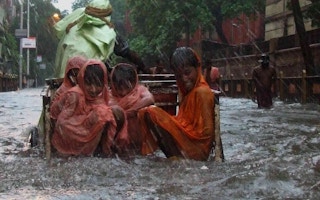In a recent address to the UN Security Council, Secretary General António Guterres warned that rising sea levels would create a “mass exodus” on a “biblical scale”.
To continue reading, subscribe to Eco‑Business.
There's something for everyone. We offer a range of subscription plans.
- Access our stories and receive our Insights Weekly newsletter with the free EB Member plan.
- Unlock unlimited access to our content and archive with EB Circle.
- Publish your content with EB Premium.
While climate-induced migration has emerged as a significant global challenge, the intricacies of climate migration – in the context of the socio-political and economic systems at the local, regional, intra-country, and global level – are often not understood. With South Asia set to bear the brunt of global heating, it is imperative to note the realities and multifaceted nature of climate-induced migration in the region to chart the way forward.
Much of the research on climate change and migration is focused on developing countries, including regions in South Asia. Yet public discourse on this phenomenon continues to be framed by the global North – popular narratives often focus on cross-border movements, but evidence suggests that most climate migration trends are internal. According to the World Bank, there could be 40 million internal climate migrants within South Asia in the next 25 years or so.
Migration due to climate change can be both short- and long-term. While rapid natural disasters like floods and hurricanes can lead to a short-term displacement of people, slow-onset climate change events like rising sea levels and desertification can drive a more permanent migration away from the impacted regions. India Migration Now’s research confirms that migration is a multi-causal, expensive endeavour, and often, those with the greatest vulnerability to climate change lack the resources to successfully move to more stable regions.
Understanding the nuances and the specific context
Often migration due to climate change is viewed as a last resort, a failure of developmental policy, but in South Asia, migration has long been used as a coping strategy for weather and climate events. The region already has strong patterns of seasonal, crop cycle-related migration. Increasingly, intensifying extreme weather events are affecting agricultural cycles that in turn impact livelihoods. While climate change’s impact on livelihoods influences the decision to migrate, new studies suggest that the ultimate decision to move to less climate vulnerable regions also depends on various social, natural, and financial factors.
For instance, caste and economic hierarchy and social segregation of the labour market have been shown to influence the decision to migrate. Research shows that the historically marginalized caste and tribal communities termed “SCs (scheduled castes) and STs (scheduled tribes) ” benefit less from migration as social discrimination continues to impact them in the places they migrate to. Climate migration also acts as a “threat multiplier” when it interacts with the existing vulnerabilities of age, gender and livelihoods, generating a complex spectrum of climate-vulnerable people.
For instance, many disaster-prone Himalayan areas of Uttarakhand in northern India have for decades, witnessed a mass exodus to nearby towns and cities in search of jobs, leaving behind ‘ghost villages’. On the other hand, in the flood-prone regions of Assam state in northeastern India, people choose to stay on because they don’t expect better income prospects in cities. Also, climate-induced migration might have at least some benefits: a 2017 study in the central Indian state of Bihar found that rural farming families that migrated due to climate risk now benefit from livelihood diversification, transfer of skills and remittances, helping those left behind in the village improve their climate resilience.
South Asia has also witnessed climate-induced displacement – for instance, in Pakistan, sea-water intrusion and lack of fresh water in the Indus delta have forced coastal communities in the country’s south-eastern Sindh region to migrate to the fishing villages along the coast of Karachi, the country’s most populous city.
Here are some ways to begin thinking about climate migration in South Asia that reflects the ground realities of climate-vulnerable populations:
- Make climate migration a policy area
Climate migration is a crucial challenge to policymakers but its study has evolved somewhat independently from other fields that study climate change. Rather than take a simplified view of climate migration as a mass exodus that leaves out the decision-making power as well as the vulnerability of regions and peoples, it is important to situate climate migration within specific contexts. People’s movement from disaster-struck areas is vastly different from the migration of populations impacted by rising sea levels, for instance.
Evidence from South Asia in particular suggests that climate migration may largely take place internally, which highlights the importance of understanding internal migration flows in order to implement and evaluate climate adaptation policies and strategies. In India, the Inter State Migrant Policy Index (IMPEX) evaluates policy areas relevant to the integration of internal migrants and is based on evidence on record.
Moving forward, climate migration needs to be studied as a policy area on its own, and in conjunction with various related policy and climate adaptation measures.
- Study migration as an adaptive strategy
Climate policy must focus as much on adaptation strategies as on mitigation. Local and indigenous knowledge can provide insights into the ground realities of climate-vulnerable areas, which in turn can help build a framework for climate adaptation. In recent years, migration has been championed as a component of climate adaptation, as it also affords at-risk households new livelihoods and a chance to build their resilience and agency. Sri Lanka’s National Adaptation Plan is a case in point.
- Have more dialogues at the local level
Involve grassroots movements, activists, socio-economic actors in local communities, the new generations among migrants, and displaced peoples in these dialogues. In case of natural disasters, local leaders are best placed to design policies that promote climate resilience and adaptation and to mobilise local community action. A good way to involve local communities is by decentralising climate migration policy and plans.
While these methods are not exhaustive or without their implementation challenges, they outline the crucial reframing needed to understand climate migration. As South Asia continues to be impacted by this phenomenon, regional and national actors must consider the complexity of climate migration beyond policies that aim to restrict or forcefully relocate vulnerable populations, in favour of a regional approach to climate policy that recognises migration as a means of climate adaptation and resilience.
Nidhi Menon is a research associate at India Migration Now, a migration data, research and advocacy organisation. Pooja Bhatia is part of the editorial and communications team at India Migration Now.












